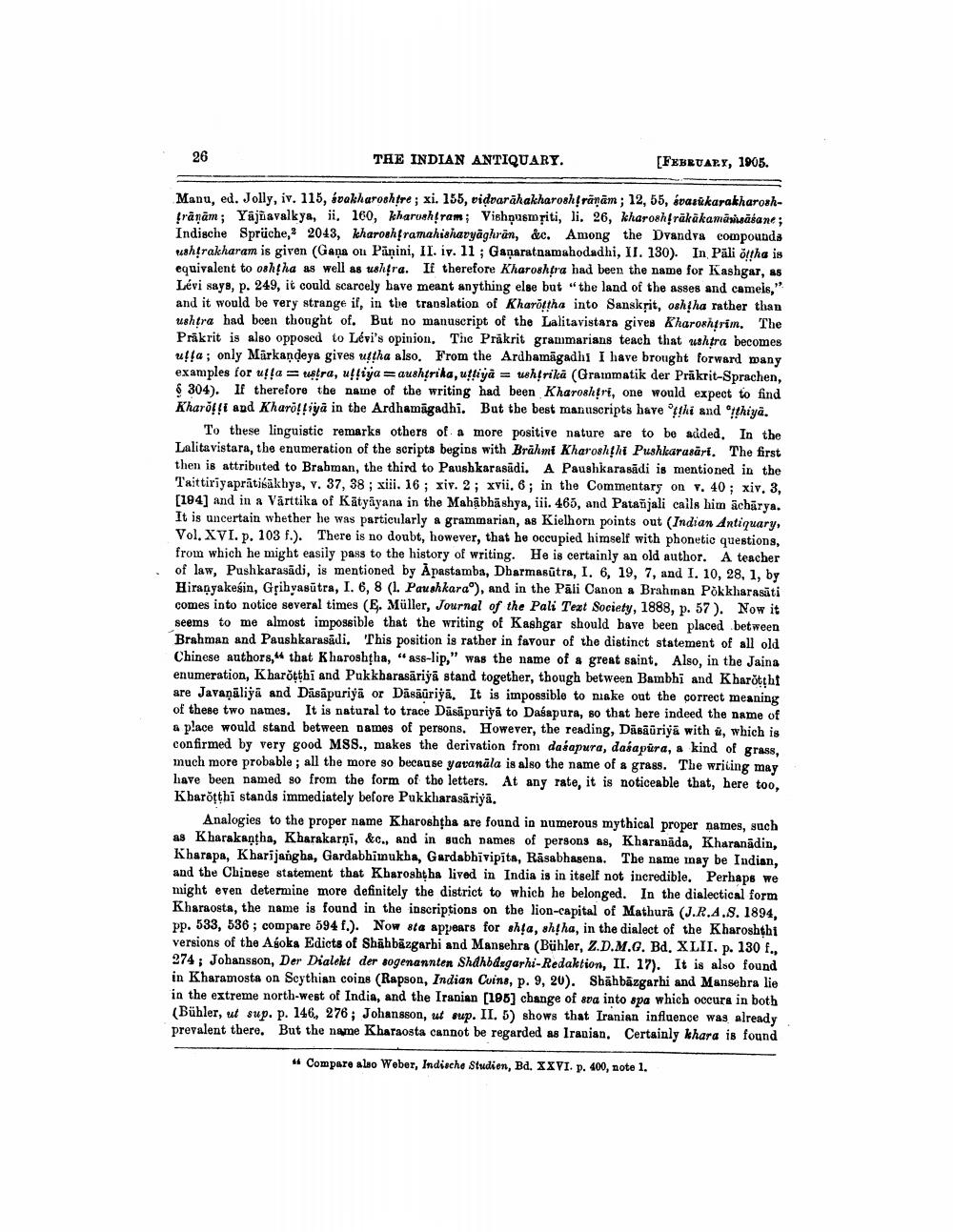________________
26
THE INDIAN ANTIQUARY.
[FEBRUARY, 1905.
Manu, ed. Jolly, iv. 115, svakharoshtre; xi. 155, vidvarāhakharoshIrānām; 12, 55, évasikarakharoshfrānām; Yajiavalkya, ii. 160, kharushi ram; Vishņuempiti, li. 26, kharoshfräkākamāšsāśane; Indische Sprüche,4 2043, kharoshframahishavyāghrän, &c. Among the Dvandva compounds ushtrakharam is given (Gana on Pāņini, II. iv. 11 ; Ganaratnamshodadhi, II. 130). In Pāli ottha is equivalent to oshtha as well as ushfra. If therefore Kharoshtra had been the name for Kashgar, as Lévi says, p. 249, it could scarcely have meant anything else but the land of the asses and camels," and it would be very strange if, in the translation of Kharottha into Sanskrit, oshịha rather than ushtra had been thought of. But no manuscript of the Lalitavistars gives Kharoshtrim. The Prakrit is also opposed to Lévi's opinion, The Präkrit grammarians teach that ushtra becomes utta; only Markandeya gives uttha also. From the Ardbamāgadhi I have brought forward many examples for uļļa = ustra, ulliya =aushịrika, utliyà = ushtrika (Grammatik der Prakrit-Sprachen, 6304). If therefore the name of the writing had been Kharoshtri, one would expect to find Kharoļļi and Kharo!!iya in the Ardhamagadhi. But the best manuscripts have thi and tthiya.
To these linguistic remarks others of a more positive nature are to be added. In the Lalita vistara, the enumeration of the scripts begins with Brāhmi Kharoshthi Pushkarasari. The first then is attributed to Brahman, the third to Paushkarasādi, A Paushkarasādi is mentioned in the Taittiriyaprāti ākhys, v. 37, 38 ; xiii. 16 ; xiv. 2 ; xvii, 6; in the Commentary on v. 40 ; xiv. 3, [194] and in a Värttika of Kātyayana in the Mahabhäshya, iii. 465, and Patañjali calls him acharya. It is uncertain whether he was particularly a grammarian, as Kielhorn points out (Indian Antiquary, Vol. XVI. p. 103 f.). There is no doubt, however, that he occupied himself with phonetic questions, from which he might easily pass to the history of writing. He is certainly an old author. A teacher of law, Pushkarasādi, is mentioned by À pastamba, Dharmasūtra, I. 6, 19, 7, and I. 10, 28, 1, by Hira yakeğin, Gșihyasūtra, I. 6, 8 (1. Paushkara”), and in the Pāli Canon a Brahman Pökkharasīti comes into notice several times (E. Müller, Journal of the Pali Text Society, 1888, p. 57). Now it seems to me almost impossible that the writing of Kashgar should bave been placed between Brahman and Paushkarasādi. 'This position is rather in favour of the distinct statement of all old Chinese authors, that Kharoshtha, "ass-lip," was the name of a great saint. Also, in the Jaina enumeration, Kharõ(thi and Pukkbarasārijā stand together, though between Bambhi and Kharotthi are Javaņālija and Dāsāpuriya or Däsāūrijā. It is impossible to niake out the correct meaning of these two names. It is natural to trace Düsāpurijā to Dasapura, so that here indeed the name of a place would stand between Dames of persons. However, the reading, Dābāūriya with it, which is confirmed by very good MSS., makes the derivation from da apura, dasapura, a kind of grass, much more probable; all the more so because yaranāla is also the name of a grass. The writing may have been named so from the form of the letters. At any rate, it is noticeable that, here too, Kbaroţthi stands immediately before Pukkharasārijā.
Analogies to the proper name Kharoshtha are found in numerous mythical proper names, such as Kharakantha, Kharakarņi, &c., and in sach names of persons as, Kharanada, Kharanadin, Kharapa, Kharijangha, Gardabhimukha, Gardabhivipita, Rasabhasena. The name may be Indian, and the Chinese statement that Kharoshtha lived in India is in itself not incredible. Perhaps we might even determine more definitely the district to which he belonged. In the dialectical form Kharaosta, the name is found in the inscriptions on the lion-capital of Mathuri (J.R.A.S. 1894, pp. 533, 536 ; compare 594 f.). Now 8ta appears for shta, shtha, in the dialect of the Kharoshthi versions of the Asoka Edicts of Shahbäzgarbi and Mansehrs (Bühler, Z.D.M.G. Bd. XLII. p. 130 f., 274 ; Johansson, Der Dialekt der sogenannten Shahbdsgarhi-Redaktion, II. 17). It is also found in Kharamosta on Scythian coins (Rapson, Indian Coins, p. 9, 20). Shāhbāzgarhi and Mansehra lie in the extreme north-west of India, and the Iranian [195] change of sva into spa which occurs in both (Bühler, ut sup. p. 146, 276; Johansson, ut sup. II. 5) shows that Iranian influence was already prevalent there. But the name Kharaosta cannot be regarded as Iranian. Certainly khara is found
Compare alao Weber, Indische Studien, Bd. XXVI. p. 400, note 1.




